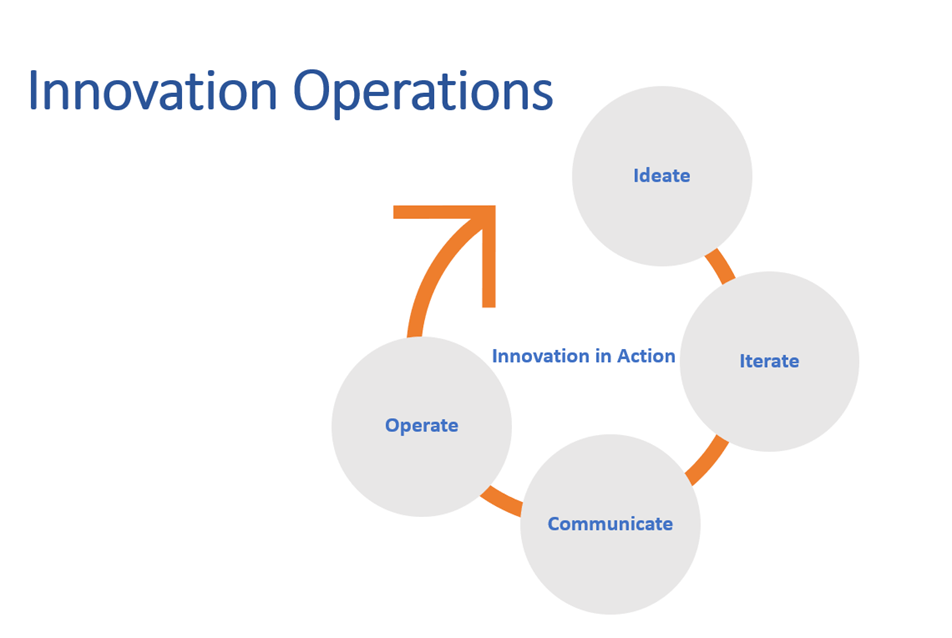Innovation in Action: A Toolkit for Taking a New Idea from Inspiration to Operation

Are you reading this by candlelight? Probably not. Most likely, you’re reading this with a lovely glow of electric light illuminating your vision. And if that’s the case, then you have Thomas Edison to thank. Edison invented the lightbulb, along with a myriad of other existence-shaping innovations that make our lives today easier, faster, cleaner, and simpler. We can learn a great deal from Edison about innovation – the process of creating a new method, idea, or product. He dedicated his life to it.
Corporate jargon today often invokes innovation as the blanket term for coming up with new ideas or suggestions. But for Edison, innovation was actually all in the doing. He stipulated: “The value of an idea lies in the using of it.” As Edison knew, true innovation is not about “ideating” or “conceptualizing” or diagrams or schematics. Innovation is about the path to making your idea a reality. In this article, we outline a toolkit you can use to make sure that your innovation becomes a living, breathing invention in your organization. You’ve already heard about DevOps, MLOps, and DataOps.
Today, we’ll talk about “InnovOps.”
Innovation: Know your “Why”
Before we dive into the mechanics of a successful innovation operation, let’s remember why innovation matters. What are you trying to achieve? Throughout the course of history, innovation has been the transformative force behind global humanitarian development, economic prosperity and growth, and social mobility. The World Economic Forum recognizes innovation as “critical to the future well-being of society and to driving economic growth.” In your day-to-day, innovation could be the route to improved operational effectiveness, cost reduction, or improved employee well-being.
A report by the consultancy McKinsey & Company recently estimated that the COVID-19 crisis has accelerated digital adoption by global companies by three to four years. A study by Northeastern University noted that 90 percent of the world’s data has been created in the last couple of years. How are you keeping pace with the rate of change? Innovation is essential to business performance and growth – and you can differentiate yourself by building a toolkit to make change happen in your organization.
What do you need to run a successful Innovation Operation?
We take our starting principle on how to run a seamless Innovation Operation from a maxim with military origins: KISS: Keep It Simple, Stupid. We came up with a simple four-step framework that you can use to introduce more innovation into any team, company, or organization:

- Ideate: Coming up with ideas is the first step on your journey to running an Innovation Operation. How do you cultivate ideas? Read, listen, pay attention to the world around you. Ruthlessly prioritize your time and energy, so that your brain is sufficiently expansive to absorb new information. You might also turn to a manual or program designed to structure the process of inspiration. The superlative A Technique for Producing Ideas has only grown in relevance since it galvanized the advertising industry in 1965, while the iconic manual, The Artist's Way, offers a structured way to unlock an inner recess of creativity for burnt-out technologists, executives, and founders. Make connections between what your team is doing every day and what is going in the world outside. There are innumerable ways for this to benefit your mission.
- Iterate: You have a list of ideas, and a heart full of inspiration. Next, it’s time to iterate and refine. Accept that – in big handfuls – for every fifty ideas you generate, twenty will have merit, ten of those will be worth refining further, and three should be nurtured until they live and breathe in your organization. The others can be set aside – deliberately deprioritized until they’re more relevant or ready to evolve. Use whatever data you can find, collect, or generate to size the potential of your ideas and iterate on them. Remember that data can be qualitative as well as quantitative – financial data, surveys, focus groups, interviews, articles, and discussions can all help you to refine your thesis and decide which ideas have the most potential in your organization.
- Communicate: Spoiler alert – this is where many ideas come unstuck. Do not fall into the trap of the overenthusiastic innovator who is so impassioned with their idea that they neglect to bring others with them. Think about which functions, teams, or individuals are going to be affected (positively or negatively) if your idea comes to fruition. Who will likely sponsor, support, or detract from your idea? What do they care about? How can you use active listening to understand their perspective? The former FBI hostage negotiator, Chris Voss, illuminates how emotion, trust, and empathy will be your friends in helping to position a new idea or concept positively for the critical influencers in your organization.
- Operate: Once you have validated your idea, fostered consensus, and are ready to build, apply the classic principles of program management: Set a timeline, clarify expectations, and define success. Define how you will monitor, refine, and manage the new idea or process so that it lives in a state of continuous improvement. Guarantee accountability by appointing an owner for all of the critical components of the new initiative – and soon it won’t be just a new idea, but a critical enabler of your organization’s performance and growth.
Further reading
- McKinsey on Digital Adoption during COVID-19
- World Economic Forum - Technology Pioneers
- Pew Research - Impact on Technology on Improving Life
- Northeastern University - The Importance of Innovation
- The Innovator's Dilemma
- A Technique for Producing Ideas
- The Artist's Way
- Never Split the Difference









